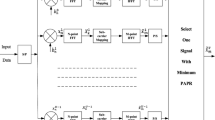Abstract
This paper presents a novel low complexity technique for reducing the peak-to-average power ratio (PAPR) in orthogonal frequency division multiplexing systems followed by an efficient hardware co-simulation implementation of this technique by using a Xilinx system generator on field programmable gate array. In this technique, the output of inverse fast Fourier transforms (IFFT) is partitioned into M subblocks, which are subsequently interleaved. Then, a new optimization scheme is introduced in which only a single two phase sequence need to be applied. Unlike the conventional partial transmit sequence (C-PTS) which needs M-IFFT blocks and \(W^{M-1}\) iterations, the proposed technique requires only a single IFFT block and M iterations. These features significantly reduce processing time and less computation that leads to reduced complexity. Simulation results demonstrate that the new technique can effectively reduce the complexity up to 99.95% compared with the conventional PTS (C-PTS) technique and yields good PAPR performance. The good PAPR performance arises from the effect of both the data interleaving and the new optimization technique. Through the comparison of performance between simulation and hardware, it is distinctly illustrated that the designed hardware block diagram is as workable as the simulation, and the difference of the result is only 0.1 dB.























Similar content being viewed by others
References
Rahmatallah, Y., & Mohan, S. (2013). Peak-to-average power ratio reduction in OFDM systems: A survey and taxonomy. IEEE Communications Surveys and Tutorials, 15(4), 1567–1592.
Han, S. H., & Lee, J. H. (2005). An overview of peak-to-average power ratio reduction techniques for multicarrier transmission. IEEE Wireless Communication, 12(2), 56–65.
Jiang, T., & Wu, Y. (2008). An overview: Peak-to-average power ratio reduction techniques for OFDM signals. IEEE Transactions on Broadcasting, 54(2), 257–268.
Lim, D. W., Heo, S. J., & No, J. S. (2009). An overview of peak-to-average power ratio reduction schemes for ofdm signals. Journal of Communications and Networks, 11(3), 229–239.
Al-Hussaini, K., Ali, B. M., Varahram, P., & Hashim, S. J. (2016). A novel low complexity high efficiency hybrid PAPR reduction for OFDM systems. In 2015 IEEE 12th Malaysia International Conference on Communications (MICC) (MICC15) (pp. 345–350).
Al-Hussaini, K., Ali, B. M., & Varahram, P. (2013). A method of peak to average power ratio (PAPR). Patent No. PI 2013702570.MY.
Müller, S. H., & Huber, J. B. (1997). OFDM with reduced peak-to-average power ratio by optimum combination of partial transmit sequences. Electronics Letters, 33(5), 368–369.
Varahram, P., & Ali, B. M. (2011). Partial transmit sequence scheme with new phase sequence for PAPR reduction in OFDM systems. IEEE Transactions on Consumer Electronics, 57(2), 366–371.
Jacklin, N., & Zhi Ding, D. (2013). A linear programming based tone injection algorithm for PAPR reduction of OFDM and linearly precoded systems. IEEE Transactions on Circuits and Systems I: Regular Papers, 60(7), 1937–1945.
Yafei, H., & Hase, T. (2008). PAPR reduction for OFDM system using partial symbol transmission. In 4th IEEE international conference on circuits and systems for communications. ICCSC 2008 (pp. 1–5).
Pandey, P., & Tripathi, R. (2013). Computational complexity reduction of OFDM signals by PTS with alternate optimised grouping phase weighting method. International Journal of Computer Applications, 78(1), 1–7.
Mukunthan, P., & Dananjayan, P. (2014). Modified PTS with interleaving for PAPR reduction of OFDM signal with QPSK subblock. International Journal of Future Computer and Communication, 3, 1–8.
Liu, J., Zhang, W., Yuan, Z., & Ma, T. (2011). Low complexity PTS algorithm based on gray code and its FPGA implementation. In ICEMI 2011 10th international conference (pp. 208–211).
Varahram, P., & Ali, B. M. (2011). FPGA implementation of novel peak-to-average power ratio reduction in orthogonal frequency division multiplexing systems. In 17th Asia-Pacific conference on communications (APCC) (pp. 264–268).
Goldsmith, A. (2005). Wireless communications, Chap 12. Cambridge: Cambridge University Press.
Sabbir, A., & Makoto, K. (2013). Interleaving effects on BER fairness and PAPR in OFDMA system. Telecommunication Systems, 52, 183–193.
Alavi, A., Tellambura, C., & Fair, I. (2005). PAPR reduction of OFDM signals using partial transmit sequence: An optimal approach using sphere decoding. IEEE Communications Letters, 9(11), 982–984.
Taspinar, N., Kalinli, A., & Yildirim, M. (2011). Partial transmit sequences for PAPR reduction using parallel tabu search algorithm in OFDM systems. IEEE Communications Letters, 15(9), 974–976.
Wang, Y., Chen, W., & Tellambura, C. (2010). A PAPR reduction method based on artificial bee colony algorithm for OFDM signals. IEEE Transactions on Wireless Communications, 9(10), 2994–2999.
Cho, Y., No, J., & Shin, D. (2012). A new low-complexity PTS scheme based on successive local search using sequences. IEEE Communications Letters, 16(9), 1470–1473.
Acknowledgements
This work was supported by Universiti Putra Malaysia under the Prototype Development Research Grant Scheme (PRGS) of the Ministry of Higher Education, Malaysia. (No. 5528700).
Author information
Authors and Affiliations
Corresponding author
Rights and permissions
About this article
Cite this article
Al-Hussaini, K., Ali, B.M., Varahram, P. et al. Designing and Implementing a Novel Single IFFT Scrambling PAPR Reduction Scheme in OFDM Systems Using FPGA with Hardware Co-simulation. Wireless Pers Commun 95, 4763–4788 (2017). https://doi.org/10.1007/s11277-017-4123-5
Published:
Issue Date:
DOI: https://doi.org/10.1007/s11277-017-4123-5




